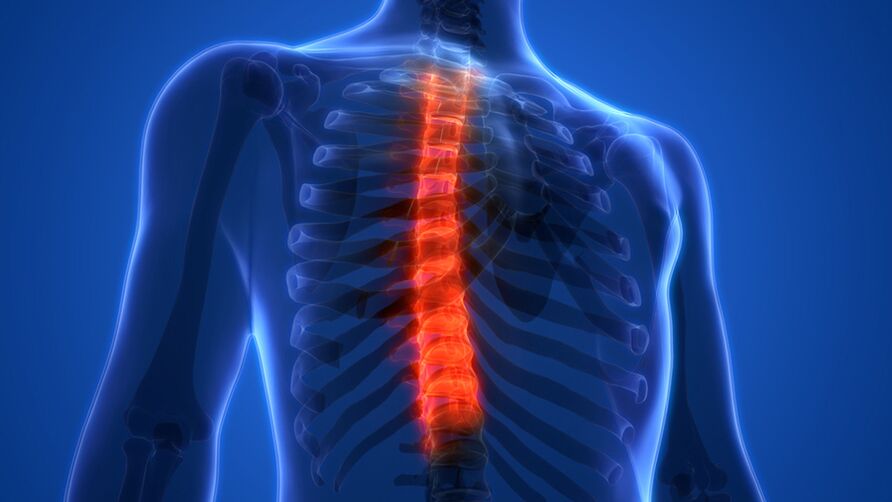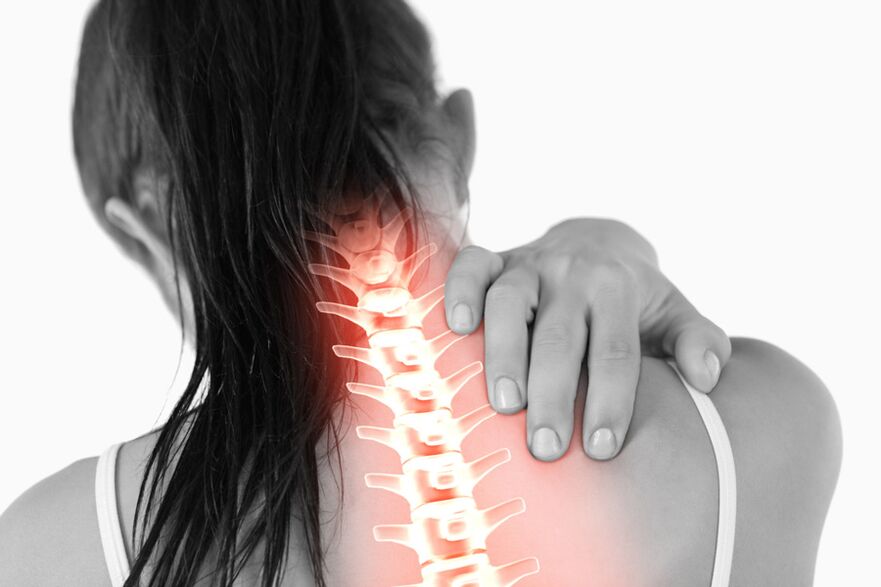
Osteochondrosis of the thoracic spine is a degenerative-dystrophic disease of the intervertebral disc, which most often affects the thoracic spine. It is characterized by further changes and destruction of the intervertebral disc, which can cause functional impairment and cause symptoms of pain and discomfort.
The main reasons for development:
- Passive lifestyle.
- Incorrect long-term position of the spine (for example, due to long periods of sitting in front of the computer).
- Spinal cord injury.
- Obesity and overweight.
- Genetic predisposition.
Main symptoms:
- Pain in the chest area.
- Burning or tingling sensation in the back.
- Limited movement in the thoracic spine.
- Chest pain when moving or taking a long breath.
Features in women:
- The pain can be thought of as pain in the heart area.
- Increased symptoms during the premenstrual period.
- Relationship with hormonal changes in the body.
Treatment of osteochondrosis of the thoracic spine aims to eliminate symptoms and restore the function of the spine. Includes conservative methods (drug treatment, massage, physiotherapy) and, in rare cases, surgery.
Causes of the development of thoracic osteochondrosis
Osteochondrosis of the thoracic spine is a disease of complex origin that occurs as a result of a combination of external and internal factors. Let's detail the reasons for its development:
Biochemical changes:
- An imbalance in the content of microelements, especially calcium and phosphorus, which leads to a deterioration in the nutrition of the intervertebral disc.
- Metabolic disorders in the spinal tissue due to disorders in the function of internal organs such as the liver, kidneys and gastrointestinal tract.
Hormonal factors.
Changes in the level of sex hormones, especially estrogen, can cause degeneration of connective tissue, including intervertebral discs.
Anatomical features.
Congenital abnormalities of the spine structure, such as joint hypermobility or abnormal formation of vertebrae.
Professional factors:
- Frequent static loads on the spine, especially when lifting and carrying heavy objects.
- Prolonged in a forced position related to professional activity.
Diseases and illnesses:
- Chronic inflammatory processes such as rheumatoid arthritis, ankylosing spondylitis, etc.
- Circulatory diseases, including varicose veins and thrombophlebitis.
Thoracic osteochondrosis: main symptoms
Thoracic osteochondrosis is manifested by a number of specific symptoms, which may vary in severity and combination. Let's take a closer look at the main manifestations of this disease:
- Pain in the chest area.Unpleasant sensations can be either acute or dull, sometimes intensifying with movement, coughing or deep breathing.
- Intercostal neuralgia.The pain spreads along the intercostal nerve, creating a feeling of "squeezing" the chest.
- Limited mobility.Stiffness in the thoracic spine, especially in the morning or after a long stay in one position.
- Increased fatigue.General weakness, fatigue during physical activity.
- Internal organ dysfunction.In some cases, problems with the heart, lungs or gastrointestinal tract may occur due to compression of the spinal cord.
- Paresthesia.A "crawling", numb or burning sensation in the chest area and along the ribs.
- Violation of posture.Spinal curvature, postural changes due to chronic pain and muscle imbalances.
Symptoms of thoracic osteochondrosis in women
Although many symptoms of thoracic osteochondrosis are universal for both sexes, women may have some peculiarities in the manifestation of this disease. Let's study them in more detail:
- Acute pain in the chest area.In women, more often than in men, pain may resemble symptoms of angina or other heart disease.
- Pain when putting pressure on the chest.It is especially important for women during breastfeeding or with mastopathy, when enlarged mammary glands create additional pressure on the thoracic spine.
- Pain in the neck and shoulder blades.Often, the symptoms of osteochondrosis in women can radiate to the cervical area or shoulder blade area.
- Feeling heavy in the chest.These symptoms may be combined with discomfort when wearing a bra, especially if there is a bone disorder.
- Hormonal factors.Changes in hormone levels in a woman's body, especially during menstruation, pregnancy or menopause, can increase or change the nature of osteochondrosis symptoms.
It is important to remember that many of these symptoms can be similar to other diseases. Therefore, if discomfort or pain occurs in the chest area, especially in women, it is recommended to see a doctor for an accurate diagnosis.
Thoracic osteochondrosis: pain in the sternum
Chest pain is a rather worrisome symptom that can indicate many different conditions, from heart disease to gastroesophageal reflux. However, in patients with thoracic osteochondrosis, this feeling is often the dominant symptom. Let's consider the characteristics of this manifestation:
- Nature of pain.Pain with osteochondrosis of the thoracic region in the sternum region is often described as sharp, burning or squeezing. It may get worse with movement, coughing, or deep breathing.
- Localization.The pain is usually localized in the center of the chest, but may radiate to the arms, neck, or abdomen.
- Period.Unlike angina, pain from osteochondrosis can last for hours or even days without relief.
- Associated symptoms.Chest pain is often accompanied by numbness or tingling in the arms, and increased pain when turning or bending over.
- Differential diagnosis.The importance of differential diagnosis cannot be underestimated. Pain in the sternum caused by thoracic osteochondrosis should be different from pain of cardiac, pulmonary or gastroenterological origin.
If you experience chest pain, you should see a doctor as soon as possible. Since the symptoms of many diseases can overlap, only a qualified specialist can make the correct diagnosis and prescribe the appropriate treatment.
Intercostal osteochondrosis and its characteristics
Intercostal osteochondrosis refers to lesions of the intercostal joints, which provide mobility of the ribs in relation to the spine. Pathology of this joint can cause characteristic pain, especially when moving and breathing.
- Nature of pain.Pain due to intercostal osteochondrosis is acute, aggravated by movement, deep breathing, coughing or sneezing. It can mimic pain in the heart, stomach or liver, making diagnosis difficult.
- Localization.Pain is most often localized at the junction of the ribs with the spine or sternum, and can radiate to the anterior or posterior surface of the chest.
- Additional symptoms.With intercostal osteochondrosis, numbness and tingling in the corresponding intercostal space, as well as increased skin sensitivity in this area, may occur.
- Diagnostics.Diagnosis of intercostal osteochondrosis may require radiography, MRI or ultrasound of the thoracic spine, as well as the exclusion of cardiology, lungs and other causes of pain.
- Treatment.Therapy for intercostal osteochondrosis aims to eliminate inflammation and pain, as well as correct posture disorders and movement patterns.

The importance of timely diagnosis and treatment of intercostal osteochondrosis is to prevent chronic pain syndrome and maintain full chest function.
Diagnosis of thoracic chondrosis: the main research method
Accurate diagnosis of thoracic osteochondrosis requires an integrated approach, including clinical, laboratory and instrumental research methods. The study will help determine the extent of damage to the spine, its location and identify possible complications.
- Clinical examination.The doctor takes an anamnesis, knowing the nature of the complaint, the duration and circumstances of the incident. The examination allows you to assess the condition of the spine, the patient's posture, the presence of deformities and painful points.
- Radiography.This method allows you to get an image of the spine and determine the degree of its degenerative changes, the presence of osteophytes, a decrease in the height of the intervertebral disc and other anomalies.
- Magnetic resonance imaging (MRI).MRI provides detailed layered images of soft tissues, intervertebral discs, spinal cord, and spinal roots. This is the most informative method for diagnosing thoracic osteochondrosis, allowing to identify disc herniations and protrusions, inflammatory processes and other pathologies.
- Computed tomography (CT).Less commonly used than MRI, it can also be useful for detailed studies of the bony structure of the spine.
- Electromyography (EMG).This method studies the electrical activity of muscles and can be used to determine the extent of nerve root damage.
- Laboratory research.The focus is on general blood tests, which can show the presence of inflammatory processes in the body.
Based on the results of all the studies performed, the doctor explains the diagnosis and develops an individual treatment plan for the patient.
How to treat thoracic osteochondrosis: modern methods and approaches
Treatment of thoracic osteochondrosis aims to eliminate pain, restore spinal function and prevent further progression of the disease. Current treatment methods include conservative and surgical approaches, as well as physical therapy and rehabilitation measures.
- Drug treatment.Prescribed to relieve pain, reduce inflammation and improve microcirculation in tissues. Drugs may include non-steroidal anti-inflammatory drugs (NSAIDs), muscle relaxants, chondroprotectors and vitamin complexes.
- Physiotherapy.Procedures such as ultrasound therapy, magnetic therapy, laser therapy and electrophoresis help reduce pain, activate blood circulation and stimulate regenerative processes in tissues.
- Manual therapy.It is carried out by qualified specialists and aims to correct the position of the vertebrae, relieve muscle spasms and restore joint mobility.
- Exercise therapy (physical therapy).Individually selected sets of exercises help strengthen the back muscles, improve posture and prevent further spinal deformity.
- Orthopedic products.Wearing a corset or belt may be recommended to stabilize the spine and reduce pressure on the affected area.
- Surgery.It is used in cases where conservative methods are ineffective, and also in the presence of serious complications, such as herniated intervertebral discs or spinal cord compression.
The choice of treatment method depends on the stage of the disease, the intensity of the symptoms, the presence of complications and the individual characteristics of the patient. The approach to treatment is always individual and determined by the doctor after a detailed diagnosis.
Treatment of thoracic osteochondrosis in women
Treatment of osteochondrosis in women requires special attention, taking into account specific gender characteristics, hormonal changes and possible related factors. Taking into account these nuances, specialists develop a comprehensive treatment plan, which may include the following methods:
- Hormone correction.Hormonal changes such as menopause can affect bone health. In some cases, correction of hormone levels using hormone replacement therapy (HRT) or other medications is recommended.
- Osteopathy.Taking into account the anatomical features of the gender allows osteopaths to carry out more acupressure and manual corrections, helping to relieve muscle spasms and improve blood circulation in certain areas.
- Treatment of complications related to pregnancy.During pregnancy, the load on the spine increases. A special set of physical exercises and wearing orthopedic products can help adapt to changes and prevent the development of osteochondrosis.
- Dietetics.Maintaining normal levels of calcium and other trace elements in a woman's body, especially during periods of hormonal fluctuations, can help in the prevention and treatment of osteochondrosis. Nutritionists develop specific nutritional recommendations.
- Psychotherapy.Women with back pain often feel stressed or depressed. Psychotherapeutic support can help in managing emotional well-being and reducing the effects of stress on physical health.
The approach to the treatment of thoracic osteochondrosis in women should be comprehensive, taking into account the individual characteristics of each patient. When choosing a treatment method, it is recommended to consult with specialists in different fields to achieve the maximum effect.
Prevention and recommendations to prevent the development of osteochondrosis
To successfully prevent the development of osteochondrosis, it is necessary to take timely measures at different stages of life. Some preventive measures can reduce the risk of this disease or significantly reduce its manifestations.
- Regular physical activity.A modern set of exercises to strengthen the back muscles and correct posture will help keep the spine in optimal condition.
- The right workplace.An ergonomic workplace, taking into account the characteristics of the spine and correct posture, helps to reduce the load on the back.
- Nutrition.A diet rich in calcium and vitamin D helps maintain healthy bones.
- Avoid over voltage.Taking frequent breaks during prolonged static work or heavy lifting will help reduce the risk of injury and excessive fatigue.
- Maintain a daily routine.Proper rest and sleep promote rapid regeneration of the spine and prevent degenerative changes.
In conclusion, osteochondrosis is a chronic disease that requires a careful approach to treatment and prevention. Using an integrated approach and following expert recommendations will minimize risk and ensure quality of life for a long time.

















































